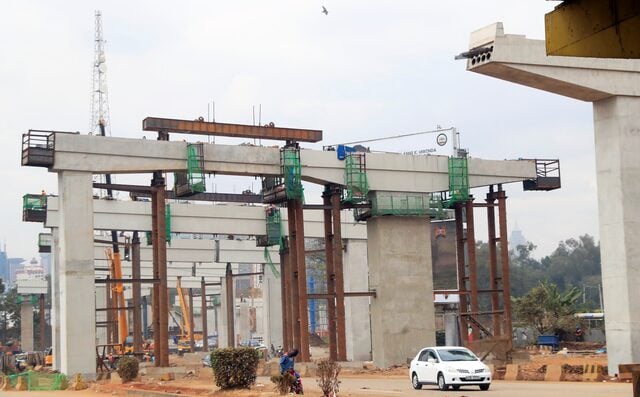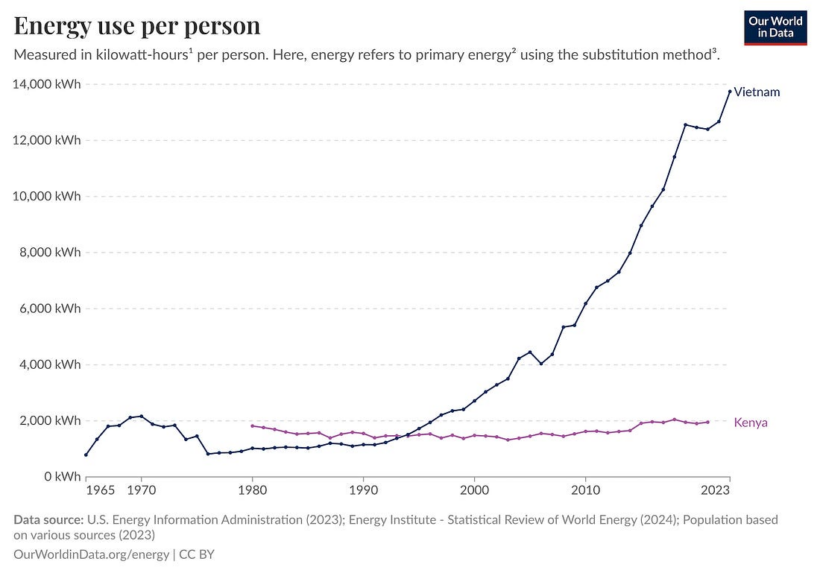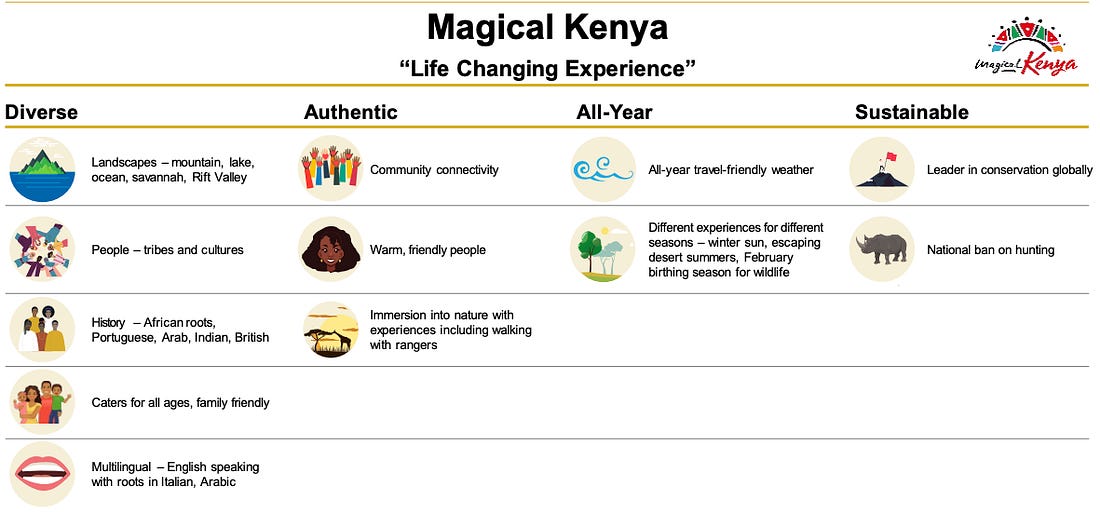Figuring out how to get things done is a major constraint to African development

The post on African elites’ lack of ambition elicited a lot of reactions and mail. The piece deserves a follow up focusing on what is to be done about the problem (I’ll get to it at some point in the near future, I have been working on some ideas). But before that, it’s worth concretizing the diagnosis with an example — in this case Kenya.
This post discusses recent comments regarding Kenyan elites by Doanh Chau, a Vietnamese energy executive. It does this for two reasons. First, the problem of lack of collective elite-level ambition across Africa is real and arguably getting worse. Therefore, it must constantly be called out in the clearest manner possible until the situation improves.
Second, that the comment came from a Vietnamese executive is apt precisely because the critique gets to the point about the ingredients needed to move the needle (elite ambition and effective state systems that deliver results irrespective of regime type or overall quality of governance at the start); as opposed to the usual bromide (basically, become a democratic and free market society with Strong Western Institutions like Denmark then you’ll grow and become rich). Stated differently, Kenya stands to benefit a lot more from studying Vietnam’s ongoing economic takeoff (warts and all) than Denmark’s.
I: Some hard truths on the quality of political leadership in Kenya from a Vietnamese executive
During a recent visit to Kenya, Doanh Chau met senior Kenyan officials, including the president. Going by his reaction, it is fair to say that he was not impressed. To get to the heart of the problems he identified, it’s worth reading his reflections after the meeting in full:
WHY AFRICA WAITS WHILE ASIA BUILDS: A Hard Look at Kenya
“I met with Prime Cabinet Secretary Musalia Mudavadi and President William Ruto in Nairobi. They spoke with energy about Kenya’s future— investment, infrastructure, public housing. But behind the polished language was a painful truth: there is no serious execution culture.
Kenya’s real problem is not a lack of money or talent. It’s the absence of long-term vision and the dominance of short-term gain. Leaders talk big, but systems don’t move. They wait for outsiders to bring business, rather than build an environment for it.
The biggest indicator? Electricity. Vietnam: 100 million people, over 70 GW of power. Kenya: 50 million people, only 4 GW.
This is not a side issue—it’s the foundation of economic development. No investor will build a factory where the lights flicker every day. Vietnam knew this. It built power generation before free trade zones, and now it’s a global export hub.
In Kenya, basic energy supply is unstable. And yet, the government built a fancy expressway from Nairobi to Mombasa—without an export industry to support it. Meanwhile, millions live in slums and huts, with no access to reliable utilities.
Tourism is another missed opportunity. Safari bookings require 90-minute check-ins at park gates—even with reservations. After 9:00 PM, everything closes. There’s nothing for visitors to experience or spend on beyond a Masai market that’s essentially a souvenir stand.
President Ruto wants to build public housing, but investors are scared off by petty corruption, and legal instability. There are no credible incentives, no serious risk guarantees. In short, no real initiative to make it happen. Compare this to Vietnam or Singapore: Leaders are up at 5 a.m. working on execution, not speeches. Power supply is constant. Policies are consistent and data-driven. Incentives align with performance.
Africa doesn’t lack potential—it lacks a mindset shift.
Leadership must stop performing for the next donor visit or summit. It must build systems that attract local and global investment, reward builders, and guarantee follow-through. The global window is closing. Asia isn’t waiting. If Kenya and much of Africa want a real economic future, they must turn off the microphone—and turn on the power.”
Doanh is spot on about Kenya’s lack of both the capacity to build things and leadership that can execute on complex projects. Overall, Kenya has a decent stock of human capital for its level of development. However, it’s also true that the talent remains thin for a range of mission-critical areas. In engineering or R&D, for example, the country is nowhere near where it should be. Kenya graduates barely 2000 engineers per year, compared to Vietnam’s well over 100,000. Vietnam has almost 5 times more R&D researchers per capita than Kenya. To make matters worse, the last decade has witnessed a systematic erosion of policymaking capacity — including within the all-important Treasury. It’s therefore not surprising that Kenya is in the midst of wrecking its education system in the name of reforms; while Vietnam continues to top the global education tables.

The erosion of capacity is what leads to the all talk and no action posture. The way I see it, President William Ruto’s biggest problem is that he hasn’t cultivated any islands of excellence. Of course everyone focuses on his governance failures. But Vietnam, the comparative case here, is an autocracy with lots of corruption. An important difference is that, unlike in Vietnam, there’s not a single ministry/department whose leadership can be trusted to execute on a complicated project. It’s simply not in the administration’s DNA to conceptualize and effectively execute. The end of policymaking is service to distributive politics. Period.
Ordinarily, someone like Cabinet Secretary Davis Chirchir (Infrastructure) would be the “doer” in the administration whose word bankable and who is empowered with the capacity to get things done. Notice that this doesn’t obviate standard politics of access, et cetera. The point is that a developing country like Kenya needs clear guarantors of predictability and risk mitigation. Yet due to his equal opportunity style of managing intra-elite distributive politics, the president has failed to effective delegate even to someone like Chirchir — who mind you, doesn’t pose a political threat to the president. This has created too many potential intra-elite veto points in pursuit of rent seeking.
The net result is that even the president lacks the capacity to be a credible guarantor of risk management strategies or overall project success. At a structural level, he’s hostage to the distributive politics he uses to keep fellow elites onside to maintain power and control. To put it bluntly, his coalition is woefully indisciplined on matters policy. Furthermore, even when he can create states of exception in order to get things done for the greater good there’s simply no capacity to back up his political resolve. Staffing in critical positions is hostage to his equal opportunity rent seeking — which is evidenced by high levels of volatility in key positions (cabinet, principal secretaries, and directors). And so absolutely nothing gets done (well).
To be fair, this isn’t a William Ruto problem. From a historical political economy perspective, you can see this in the evolution of Kenya’s politics of visible and attributable development. Senior government officials used to take pride in launching completed projects. That’s what was on the plaques. These days they build shoddy plaques for projects that are barely past the planning stage — many of which get abandoned (but the plaques remain standing!)
Cheap talk in the forms of budget allocation, project designs, and groundbreaking ceremonies have become the currency of politics as opposed finished projects.
II: On electricity and tourism in Kenya
Which brings us to the examples of electricity and tourism mentioned by Doanh. Both speak to key factors that Kenya must get right if it is to experience economic takeoff in the near future: building reliable infrastructure fast and at a reasonable financial costs; and maximizing value addition in its export products (including in tourism, which is technically an export of services).
Let’s start with electricity. Comparing Kenya and Vietnam, what you see in the data is divergence over time in both total energy supply and consumption, as well as efficiency of converting energy into economic output.
According to the IEA, electricity consumption per capita Kenya is 0.19 MWh/capita (up from 0.13MWh/capita in 1990) compared to Vietnam’s 2.67MWh/Capita (up from 0.099MWh/capita in 1990). Since 2000 electricity consumption in Vietnam has increased by over 800%, compared to Kenya’s more modest 76% increase over the same time period. Interestingly, Kenya appears to be far less efficient in converting energy supply into economic output. Kenya’s total energy supply per unit of GDP (PPP) has actually decreased by 21% since 2000 — from 6322MJ/’000 2015 USD to 5024MJ/’000 2015 USD. The commensurate figures from Vietnam decreased by a more modest 9% — from 4480 MJ/’000 2015 USDto 4061MJ/’000 2015 USD. Notice that carbon intensity decreases with levels of economic development (it turns out growth is good for climate).

Part of the reason Kenya missed the energy train in the 1990s is because it has failed to modernize its economy. As such, demand remains rather muted despite the recent increase in headline figures on electricity access — which raises the cost of access for those connected to the grid. The exit of a number of industrial power consumers who’ve opted to generate their own power, to take care of cost and reliability concerns, has exacerbated the situation. Furthermore, the government inexplicably views the throttling of energy consumption as one of its primary roles. Taxes make up about half of the costs of petroleum fuel. The country also remains saddled with very expensive (and allegedly politically motivated) power purchase agreements from independent power producers (IPPs). According to the office of the Auditor General:
KenGen [state-owned power generator] supplied a total of 8,027 gigawatt hours (GWh) being 60% of the total power purchased while the IPPs supplied the remaining 5,263 GWh (40%). However, the cost of the total power purchased from KENGEN was Kshs.54,215,880,000 equivalent to 35% compared to power purchase cost of Kshs.98,411,067,000 from IPPs, equivalent to 65%.
Over time, all of these policy failures add up. It costs about USD 0.23/KWh in Kenya compared to USD 0.081/KWh in Vietnam. Kenyan firms simply can’t be competitive on these terms.

Another interesting point of comparison between Kenya and Vietnam is on responses to climate change. While both countries have committed to reach net zero by 2050, a look at the respective fine prints — in the climate development reports — reveal divergent stories (if in doubt, just go read the conclusions of the two documents). Policy documents from Vietnam, which currently relies on coal for over 40% of its power, reveals a clear understanding of the tradeoffs at play. For example, it commits to peaking coal-fired electricity generation at 30.2GW — which alone is more than seven times Kenya’s current total installed capacity.

Kenya, on the other hand, notes in a strategy document that the scary scenario for 2050 “without further action” would be the country’s emissions rising from 20Mt CO2 in 2021 to 130Mt CO2 — which would translate to about 1.6Mt CO2 per capita, well below the current global average of 10.4Mt CO2. The country’s grand plan for decarbonization will require successful execution of massive investments in solar, electric vehicles, hydrogen, and the electrification of Kenyan homes (to take care of cooking fuels). Very little of the government’s written plans match current policies. It’s hard to shake off the feeling that Kenya’s largely externally-focused approach to net zero will merely replicate the image above — token but very costly performances of decarbonization amidst poverty and stagnation — without much else in terms of modernization of the wider economy and improvement of Kenyans’ material conditions.
How about tourism? As I noted in my previous post, African countries terribly underperform their tourism potential. The continent represents less than 2% of the global market. Why is this so? Because of poor product quality and minimal value addition as indicated by Doanh.
At a basic level, the challenge of product quality in Kenya’s tourism sector is a function of policymakers’ belief that they can create islands of excellent tourism-focused infrastructure and services amidst general squalor and neglect of basic infrastructure used by the general public. For instance, why are there 90-minute check-ins at park gates in Kenya? Because that’s what Kenyans are subjected to by their government. Why is the national airport in Nairobi such a mess? Because that is what successive governments have thought Kenyans deserve. Indeed, the failure prone systems at the parks showcase the government’s delusion that technology will solve its personnel problem of mismanagement of funds. The same goes with the quality of airports, roads, hotels, cultural offerings, etc.
The point here isn’t that the country needs top of the range infrastructure across board in order to have a high-flying tourism sector (tourist hot spots in Asia aren’t paragons of order and quality either). Rather, it’s that Kenya will struggle to be a top-tier destination if the basic foundational infrastructure is lacking. And you can’t just leapfrog this problem by building islands of functional systems for tourists and expats as Kenya has tried to do.

The failure to do more value addition in Kenya’s tourism sector also has structural roots. The country still runs a “colonial explorer” model of tourism, with emphasis on wildlife, fossilized “cultural” offerings, and “conservation.” The summary slide below from a 2022 strategy presentation by the Ministry of Tourism & Wildlife says it all. While a safari experience is magical, tourists from the potential growth markets (including from other African countries) are not necessarily looking to cosplay an 18th century European explorer.

The United States led as the largest source market, accounting for 12.8% of total arrivals, followed by Uganda (9.42%) and Tanzania (8.49%). In terms of source market increase, Tanzania was first with an increase of 42,133 from 161,157 in 2023 to 203,290 in 2024. The second most improved source market was China with an increase of 29,085, from 61,377 in 2023 to 90,462 in 2024. Notably, the United States of America came in third with an increase of 28,342 from 278,159 in 2023 to 306,501 in 2024. Other high growth markets include Somalia (27,029), Italy, (19,926) and Uganda, (19,755).
III: Conclusion
These two sectoral examples highlight some of the structural challenges facing the Kenyan economy. As illustrated by Doanh’s comment, there is currently no real urgency to improve the quality of policymaking and implementation. President William Ruto’s administration appears resigned to simply muddling through and juggling the politics that come with that strategy.
That’s partially because it’s easy to be complacent about the Kenyan economy. Growth continues to chug along (the IMF projects 4.8% in 2025). The government has so far been able to avoid default (with a lot of help from the IMF and other quarters); and can continue accessing the markets to rollover debt at high but reasonably comfortable rates. Broadly speaking, things do not feel like they are about to go to hell in a hand basket. Yet the warning signs are hard to miss. A restive un/underemployed young population is getting increasingly impatient with the ruling class. Growth isn’t producing as many jobs as it used to; with the government now proud to export domestic workers to the Gulf and abandon them to unimaginable barbarism.
There’s no sense that the country is trying to achieve anything worth mobilizing around. The two social sectors that ought to be the basis of a national social contract, education and health, are on their knees. The overwhelming evidence of invariable failure at collective action has significantly eroded government legitimacy and shredded the social fabric.
Can the Ruto administration turn things around? Yes. The clearest path to this end would be to focus on just one or two sectors and show demonstrable improvements in outcomes. It would also help to have a point person that can be trusted by the private sector to get complex things done. These developments would give the administration desperately needed breathing room (and stop the hemorrhaging of legitimacy) as Ruto campaigns for reelection in 2027. Will the administration turns things around? I doubt it. This is for the simple reason that Ruto remains hostage to the demands of political survival. He simply lacks the ability to discipline his fellow elites in the direction of an outcomes oriented execution culture. He has also lost the public due to compounding high-profile policy failures over the last 2.5 years.
Finally, I should note that this isn’t exactly a Ruto problem — although one could plausibly argue that the rate of deterioration has accelerated under his watch. His choices are partially constrained by past policies and elite-level mental models of how Kenya works. As noted by Doanh, the man and his current team are simply no match for the demands of the moment.

